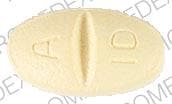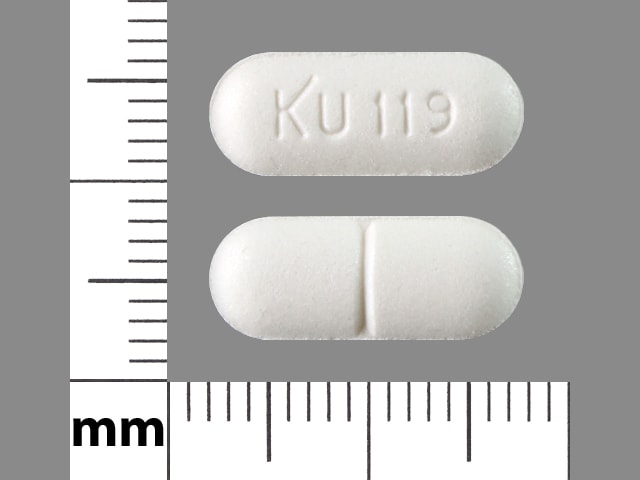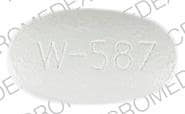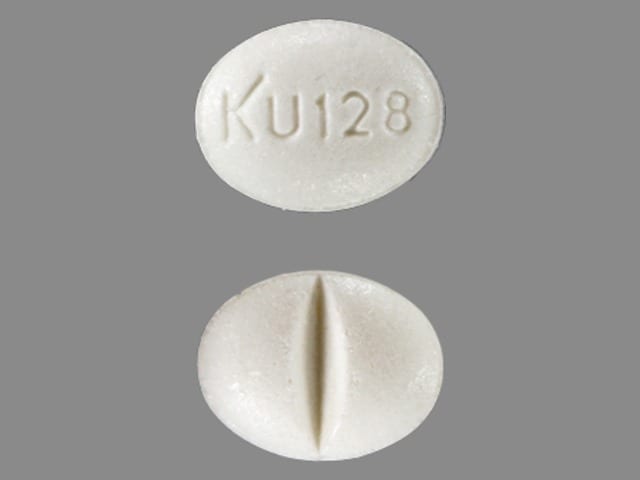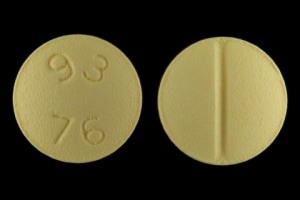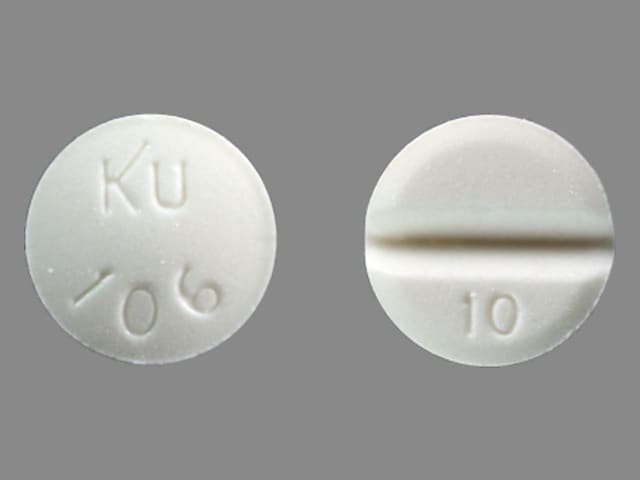Dosage Forms
Excipient information presented when available (limited, particularly for generics); consult specific product labeling.
Tablet, Oral:
Generic: 10 mg, 20 mg
Tablet Extended Release 24 Hour, Oral:
Generic: 30 mg, 60 mg, 120 mg
Pharmacology
Mechanism of Action
Nitroglycerin and other nitrates form free radical nitric oxide. In smooth muscle, nitric oxide activates guanylate cyclase which increases guanosine 3’5’ monophosphate (cGMP) leading to dephosphorylation of myosin light chains and smooth muscle relaxation. Produces a vasodilator effect on the peripheral veins and arteries with more prominent effects on the veins. Primarily reduces cardiac oxygen demand by decreasing preload (left ventricular end-diastolic pressure); may modestly reduce afterload; dilates coronary arteries and improves collateral flow to ischemic regions.
Pharmacokinetics/Pharmacodynamics
Absorption
Rapid and complete
Distribution
Vd: ~0.6 L/kg
Metabolism
Hepatic
Excretion
Predominantly urine (2% as unchanged drug); feces (1%)
Onset of Action
30 to 45 minutes (Thadani 1987)
Time to Peak
Plasma: 30 to 60 minutes
Duration of Action
Immediate release: ≥6 hours (Thadani1987); Extended release: ≥12 to 24 hours (Anderson 2007)
Half-Life Elimination
~5 to 6 hours (Thadani 1987)
Protein Binding
<5%
Use: Labeled Indications
Angina pectoris: Treatment (immediate-release only) and prevention of angina pectoris caused by coronary artery disease. Note: The onset of action of oral isosorbide mononitrate is not sufficiently rapid for this product to be useful in aborting an acute anginal episode.
Use: Off Label
Heart failure with reduced ejection fraction (HFrEF)c
Based on the American College of Cardiology Foundation/American Heart Association (ACCF/AHA) guidelines for the management of heart failure, isosorbide dinitrate (in combination with hydralazine) is effective and recommended as additional therapy to optimal guideline directed medical therapy for self-identified African-American patients with persistent NYHA class III or IV HFrEF or for patients who do not tolerate an ACE inhibitor or an angiotensin II receptor blocker (ARB). Some experts recommend isosorbide dinitrate (in combination with hydralazine) in addition to optimal guideline-directed medical therapy for black and nonblack patients with persistent NYHA class III or IV HFrEF, particularly for those with low output states or hypertension, or for patients who do not tolerate an ACE inhibitor, ARB, or angiotensin II-neprilysin inhibitor (ARNI). In order to improve compliance, it may be reasonable to replace isosorbide dinitrate with isosorbide mononitrate (in combination with hydralazine) Colucci 2019, Meyer 2019.
Contraindications
Hypersensitivity to isosorbide mononitrate, other nitrates or nitrites, or any component of the formulation; concurrent use with phosphodiesterase-5 (PDE-5) inhibitors (sildenafil, tadalafil, or vardenafil) or riociguat.
Canadian labeling: Additional contraindications (not in US labeling): Acute circulatory failure associated with marked hypotension (shock and states of collapse); postural hypotension; myocardial insufficiency due to obstruction (eg, in the presence of aortic or mitral stenosis or of constrictive pericarditis); increased intracranial pressure; severe anemia.
Dosage and Administration
Dosing: Adult
Angina pectoris: Oral: Note: Tolerance to nitrate effects develops with chronic exposure. Dose escalation does not overcome this effect. Tolerance can only be overcome by short periods of nitrate absence from the body. Recommended twice daily dosage regimens incorporate this interval. Short periods of nitrate withdrawal may help minimize tolerance.
Immediate release: 20 mg twice daily with the 2 doses given 7 hours apart (eg, 8 AM and 3 PM) to decrease tolerance development; patients with small stature may initiate therapy with 5 mg twice daily and titrate to at least 10 mg twice daily in first 2 to 3 days of therapy.
Extended release: Initial: 30 to 60 mg once daily in the morning; may titrate after several days to 120 mg once daily; rarely, 240 mg once daily may be required
Heart failure with reduced ejection fraction (off-label use): Note: As additional therapy for persistent NYHA class III or IV heart failure with reduced ejection fraction (HFrEF) despite optimal medical therapies or for patients who cannot tolerate an ACE inhibitor, angiotensin II receptor blocker (ARB), or angiotensin II-neprilysin inhibitor (ARNI). Although ACCF/AHA guidelines recommend isosorbide dinitrate with hydralazine, some experts substitute isosorbide mononitrate for isosorbide dinitrate to reduce pill burden and improve adherence (ACC/AHA/HFSA [Yancy 2017]; ACCF/AHA [Yancy 2013]; Colucci 2019; Meyer 2019).
Oral: Extended release: Initial: 30 to 60 mg once daily in combination with hydralazine 3 or 4 times daily; titrate dose every 2 to 4 weeks; maximum dose: 120 mg/day (Meyer 2019). Note: May also consider use of the fixed-dose combination of isosorbide dinitrate/hydralazine instead of separate components (ACC/AHA/HFSA [Yancy 2017]; ACCF/AHA [Yancy 2013]).
Dosing: Geriatric
Refer to adult dosing; initiate with lowest recommended dose.
Administration
Do not administer around-the-clock. Immediate release tablet should be scheduled twice daily with doses 7 hours apart (8 AM and 3 PM); administer extended release tablet once daily in the morning upon rising with a half-glassful of fluid. Do not chew or crush extended release tablets; may be divided in half. Due to insoluble matrix embedding, extended release tablets that are scored may be split (Gunasekara 1999).
Storage
Store at 25°C (77°F); excursions permitted to 15°C to 30°C (59°F to 86°F). Protect from moisture.
Isosorbide Mononitrate Images
Drug Interactions
Alcohol (Ethyl): May enhance the vasodilatory effect of Vasodilators (Organic Nitrates). Monitor therapy
Aprepitant: May increase the serum concentration of CYP3A4 Substrates (High risk with Inhibitors). Monitor therapy
Bosentan: May decrease the serum concentration of CYP3A4 Substrates (High risk with Inducers). Monitor therapy
Clofazimine: May increase the serum concentration of CYP3A4 Substrates (High risk with Inhibitors). Monitor therapy
Conivaptan: May increase the serum concentration of CYP3A4 Substrates (High risk with Inhibitors). Avoid combination
CYP3A4 Inducers (Moderate): May decrease the serum concentration of CYP3A4 Substrates (High risk with Inducers). Monitor therapy
CYP3A4 Inducers (Strong): May increase the metabolism of CYP3A4 Substrates (High risk with Inducers). Management: Consider an alternative for one of the interacting drugs. Some combinations may be specifically contraindicated. Consult appropriate manufacturer labeling. Consider therapy modification
CYP3A4 Inhibitors (Moderate): May decrease the metabolism of CYP3A4 Substrates (High risk with Inhibitors). Monitor therapy
CYP3A4 Inhibitors (Strong): May decrease the metabolism of CYP3A4 Substrates (High risk with Inhibitors). Consider therapy modification
Dabrafenib: May decrease the serum concentration of CYP3A4 Substrates (High risk with Inducers). Management: Seek alternatives to the CYP3A4 substrate when possible. If concomitant therapy cannot be avoided, monitor clinical effects of the substrate closely (particularly therapeutic effects). Consider therapy modification
Dapoxetine: May enhance the orthostatic hypotensive effect of Vasodilators (Organic Nitrates). Monitor therapy
Dapsone (Topical): May enhance the adverse/toxic effect of Methemoglobinemia Associated Agents. Monitor therapy
Deferasirox: May decrease the serum concentration of CYP3A4 Substrates (High risk with Inducers). Monitor therapy
Duvelisib: May increase the serum concentration of CYP3A4 Substrates (High risk with Inhibitors). Monitor therapy
Enzalutamide: May decrease the serum concentration of CYP3A4 Substrates (High risk with Inducers). Management: Concurrent use of enzalutamide with CYP3A4 substrates that have a narrow therapeutic index should be avoided. Use of enzalutamide and any other CYP3A4 substrate should be performed with caution and close monitoring. Consider therapy modification
Erdafitinib: May decrease the serum concentration of CYP3A4 Substrates (High risk with Inducers). Monitor therapy
Erdafitinib: May increase the serum concentration of CYP3A4 Substrates (High risk with Inhibitors). Monitor therapy
Fosaprepitant: May increase the serum concentration of CYP3A4 Substrates (High risk with Inhibitors). Monitor therapy
Fosnetupitant: May increase the serum concentration of CYP3A4 Substrates (High risk with Inhibitors). Monitor therapy
Fusidic Acid (Systemic): May increase the serum concentration of CYP3A4 Substrates (High risk with Inhibitors). Avoid combination
Idelalisib: May increase the serum concentration of CYP3A4 Substrates (High risk with Inhibitors). Avoid combination
Ivosidenib: May decrease the serum concentration of CYP3A4 Substrates (High risk with Inducers). Monitor therapy
Larotrectinib: May increase the serum concentration of CYP3A4 Substrates (High risk with Inhibitors). Monitor therapy
Local Anesthetics: Methemoglobinemia Associated Agents may enhance the adverse/toxic effect of Local Anesthetics. Specifically, the risk for methemoglobinemia may be increased. Monitor therapy
Lorlatinib: May decrease the serum concentration of CYP3A4 Substrates (High risk with Inducers). Management: Avoid concurrent use of lorlatinib with any CYP3A4 substrates for which a minimal decrease in serum concentrations of the CYP3A4 substrate could lead to therapeutic failure and serious clinical consequences. Consider therapy modification
MiFEPRIStone: May increase the serum concentration of CYP3A4 Substrates (High risk with Inhibitors). Management: Minimize doses of CYP3A4 substrates, and monitor for increased concentrations/toxicity, during and 2 weeks following treatment with mifepristone. Avoid cyclosporine, dihydroergotamine, ergotamine, fentanyl, pimozide, quinidine, sirolimus, and tacrolimus. Consider therapy modification
Mitotane: May decrease the serum concentration of CYP3A4 Substrates (High risk with Inducers). Management: Doses of CYP3A4 substrates may need to be adjusted substantially when used in patients being treated with mitotane. Consider therapy modification
Molsidomine: May enhance the hypotensive effect of Vasodilators (Organic Nitrates). Monitor therapy
Netupitant: May increase the serum concentration of CYP3A4 Substrates (High risk with Inhibitors). Monitor therapy
Nitric Oxide: May enhance the adverse/toxic effect of Methemoglobinemia Associated Agents. Combinations of these agents may increase the likelihood of significant methemoglobinemia. Monitor therapy
Palbociclib: May increase the serum concentration of CYP3A4 Substrates (High risk with Inhibitors). Monitor therapy
Phosphodiesterase 5 Inhibitors: May enhance the vasodilatory effect of Vasodilators (Organic Nitrates). Avoid combination
Prilocaine: Methemoglobinemia Associated Agents may enhance the adverse/toxic effect of Prilocaine. Combinations of these agents may increase the likelihood of significant methemoglobinemia. Management: Monitor patients for signs of methemoglobinemia (e.g., hypoxia, cyanosis) when prilocaine is used in combination with other agents associated with development of methemoglobinemia. Avoid lidocaine/prilocaine in infants receiving such agents. Monitor therapy
Rilmenidine: Vasodilators (Organic Nitrates) may enhance the hypotensive effect of Rilmenidine. Monitor therapy
Riociguat: Vasodilators (Organic Nitrates) may enhance the hypotensive effect of Riociguat. Avoid combination
Rosiglitazone: Vasodilators (Organic Nitrates) may enhance the adverse/toxic effect of Rosiglitazone. Specifically, a greater risk of ischemia and other adverse effects has been associated with this combination in some pooled analyses. Monitor therapy
Sarilumab: May decrease the serum concentration of CYP3A4 Substrates (High risk with Inducers). Monitor therapy
Siltuximab: May decrease the serum concentration of CYP3A4 Substrates (High risk with Inducers). Monitor therapy
Simeprevir: May increase the serum concentration of CYP3A4 Substrates (High risk with Inhibitors). Monitor therapy
Sodium Nitrite: Methemoglobinemia Associated Agents may enhance the adverse/toxic effect of Sodium Nitrite. Combinations of these agents may increase the likelihood of significant methemoglobinemia. Monitor therapy
Stiripentol: May increase the serum concentration of CYP3A4 Substrates (High risk with Inhibitors). Management: Use of stiripentol with CYP3A4 substrates that are considered to have a narrow therapeutic index should be avoided due to the increased risk for adverse effects and toxicity. Any CYP3A4 substrate used with stiripentol requires closer monitoring. Consider therapy modification
Tocilizumab: May decrease the serum concentration of CYP3A4 Substrates (High risk with Inducers). Monitor therapy
Adverse Reactions
>10%: Central nervous system: Headache (≤57%), dizziness (≤11%)
1% to 10%:
Cardiovascular: Abnormal heart sounds (≤5%), atrial arrhythmia (≤5%), atrial fibrillation (≤5%), bradycardia (≤5%), bundle branch block (≤5%), cardiac arrhythmia (≤5%), cardiac failure (≤5%), chest pain (≤5%), ECG abnormality (Q wave: ≤5%), edema (≤5%), exacerbation of angina pectoris (≤5%), extrasystoles (≤5%), flushing (≤5%), heart murmur (≤5%), hypertension (≤5%), hypotension (≤5%), intermittent claudication (≤5%), myocardial infarction (≤5%), palpitations (≤5%), tachycardia (≤5%), varicose veins (≤5%), ventricular tachycardia (≤5%), cardiovascular toxicity (2%)
Central nervous system: Anxiety (≤5%), confusion (≤5%), depression (≤5%), drowsiness (≤5%), fatigue (≤5%), hypoesthesia (≤5%), insomnia (≤5%), lack of concentration (≤5%), malaise (≤5%), migraine (≤5%), myasthenia (≤5%), nervousness (≤5%), neuritis (≤5%), nightmares (≤5%), paresis (≤5%), paresthesia (≤5%), rigors (≤5%), vertigo (≤5%), pain (4%), emotional lability (2%)
Dermatologic: Abnormal hair texture (≤5%), acne vulgaris (≤5%), diaphoresis (≤5%), leg ulcer (≤5%), pruritus (≤5%), skin rash (≤5%)
Endocrine & metabolic: Decreased libido (≤5%), hot flash (≤5%), hyperuricemia (≤5%), hypokalemia (≤5%)
Gastrointestinal: Abdominal pain (≤5%), constipation (≤5%), diarrhea (≤5%), dyspepsia (≤5%), flatulence (≤5%), gastric ulcer (≤5%), gastric ulcer with hemorrhage (≤5%), gastritis (≤5%), glossitis (≤5%), hemorrhoids (≤5%), loose stools (≤5%), melena (≤5%), nausea (≤5%), vomiting (≤5%), xerostomia (≤5%)
Genitourinary: Atrophic vaginitis (≤5%), impotence (≤5%), mastalgia (≤5%), urinary tract infection (≤5%)
Hematologic & oncologic: Hypochromic anemia (≤5%), nonthrombocytopenic purpura (≤5%), thrombocytopenia (≤5%)
Hepatic: Increased serum alanine aminotransferase (≤5%), increased serum aspartate aminotransferase (≤5%)
Hypersensitivity: Hypersensitivity reaction (2%)
Infection: Bacterial infection (≤5%), candidiasis (≤5%), viral infection (≤5%)
Neuromuscular & skeletal: Arthralgia (≤5%), asthenia (≤5%), back pain (≤5%), musculoskeletal pain (≤5%), myalgia (≤5%), myositis (≤5%), shoulder stiffness (frozen shoulder: ≤5%), tendon disease (≤5%), torticollis (≤5%), tremor (≤5%)
Ophthalmic: Blepharoptosis (≤5%), conjunctivitis (≤5%), photophobia (≤5%), visual disturbance (≤5%)
Otic: Otalgia (≤5%), perforated tympanic membrane (≤5%), tinnitus (≤5%)
Renal: Nephrolithiasis (≤5%), polyuria (≤5%)
Respiratory: Bronchitis (≤5%), bronchospasm (≤5%), cough (≤5%), dyspnea (≤5%), flu-like symptoms (≤5%), increased bronchial secretions (≤5%), nasal congestion (≤5%), pharyngitis (≤5%), pneumonia (≤5%), pulmonary infiltrates (≤5%), rales (≤5%), rhinitis (≤5%), sinusitis (≤5%), upper respiratory infection (1% to 4%), increased cough (2%)
Miscellaneous: Fever (≤5%), nodule (≤5%)
<1%, postmarketing, and/or case reports: Acute myocardial infarction, amblyopia, anorexia, asthma, bitter taste, cerebrovascular accident, increased thirst, muscle cramps, neck pain, pallor, prostatic disease, restlessness, syncope, weight loss
Warnings/Precautions
Concerns related to adverse effects:
- CNS depression: May cause CNS depression, which may impair physical or mental abilities; patients must be cautioned about performing tasks that require mental alertness (eg, operating machinery or driving).
- Hypotension/bradycardia: Severe hypotension can occur; paradoxical bradycardia and increased angina pectoris can accompany hypotension. Orthostatic hypotension can also occur; ethanol can accentuate this. Severe hypotension, particularly with upright posture, may occur with even small doses.
- Intracranial pressure increased: Nitrates may precipitate or aggravate increased intracranial pressure and subsequently may worsen clinical outcomes in patients with neurologic injury (eg, intracranial hemorrhage, traumatic brain injury) (Rangel-Castilla 2008).
Disease-related concerns:
- Cardiovascular disease: Not recommended for use in patients with acute myocardial infarction (MI) or heart failure (has not been studied). Use with caution in volume depletion and moderate hypotension, and with extreme caution with inferior wall MI and suspected right ventricular infarctions. The Canadian labeling contraindicates use in acute circulatory failure associated with marked hypotension, postural hypotension, and myocardial insufficiency due to obstruction (eg, in the presence of aortic or mitral stenosis or of constrictive pericarditis).
- Hypertrophic cardiomyopathy (HCM): Avoid use in patients with HCM with outflow tract obstruction; nitrates may reduce preload, exacerbating obstruction and cause hypotension or syncope and/or worsening of heart failure (Gersh 2011).
Concurrent drug therapy issues:
- Drug-drug interactions: Potentially significant interactions may exist, requiring dose or frequency adjustment, additional monitoring, and/or selection of alternative therapy. Consult drug interactions database for more detailed information.
- PDE-5 inhibitors: Avoid concurrent use with PDE-5 inhibitors (eg, sildenafil, tadalafil, vardenafil). When nitrate administration becomes medically necessary, may administer nitrates only if 24 hours have elapsed after use of sildenafil or vardenafil (48 hours after tadalafil use) (O’Connor 2010).
Dosage forms related issues:
- Extended-release tablets: Empty matrix "ghosts" (tablets) may pass in patients via colostomy or in the stool; this is of no concern.
Other warnings/precautions:
- Appropriate use: Extended-release: Not intended for the immediate relief of acute attacks of angina pectoris.
- Tolerance: Appropriate dosing intervals are needed to minimize tolerance development. Tolerance can only be overcome by short periods of nitrate absence from the body. Dose escalation does not overcome this effect.
Monitoring Parameters
Blood pressure, heart rate
Pregnancy
Pregnancy Risk Factor
B
Pregnancy Considerations
Adverse events have been observed in some animal reproduction studies. Nitric oxide donors, such as isosorbide, have been evaluated for pre-eclampsia and cervical ripening; isosorbide mononitrate use in these conditions is not currently recommended (Kalidindi 2012; Ramirez 2011).
Patient Education
What is this drug used for?
- It is used to prevent chest pain.
- It may be given to you for other reasons. Talk with the doctor.
Frequently reported side effects of this drug
- Headache
Other side effects of this drug: Talk with your doctor right away if you have any of these signs of:
- Chest pain
- Severe dizziness
- Passing out
- Slow heartbeat
- Fast heartbeat
- Signs of a significant reaction like wheezing; chest tightness; fever; itching; bad cough; blue skin color; seizures; or swelling of face, lips, tongue, or throat.
Note: This is not a comprehensive list of all side effects. Talk to your doctor if you have questions.
Consumer Information Use and Disclaimer: This information should not be used to decide whether or not to take this medicine or any other medicine. Only the healthcare provider has the knowledge and training to decide which medicines are right for a specific patient. This information does not endorse any medicine as safe, effective, or approved for treating any patient or health condition. This is only a brief summary of general information about this medicine. It does NOT include all information about the possible uses, directions, warnings, precautions, interactions, adverse effects, or risks that may apply to this medicine. This information is not specific medical advice and does not replace information you receive from the healthcare provider. You must talk with the healthcare provider for complete information about the risks and benefits of using this medicine.
